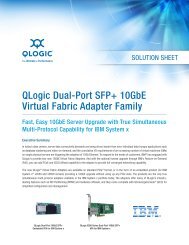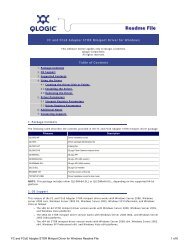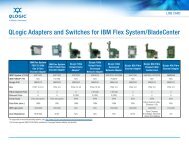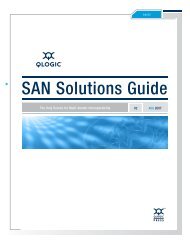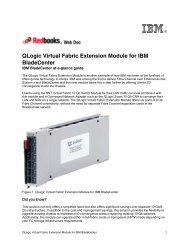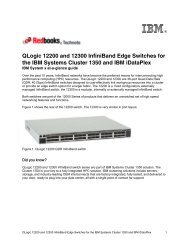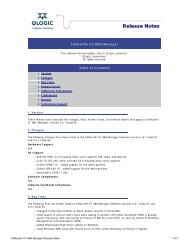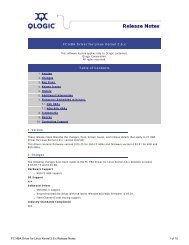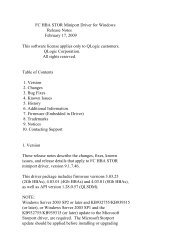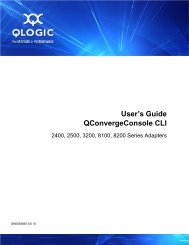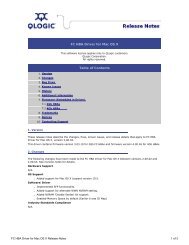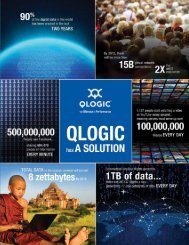Applying NIC Partitioning in Converged Network ... - QLogic
Applying NIC Partitioning in Converged Network ... - QLogic
Applying NIC Partitioning in Converged Network ... - QLogic
You also want an ePaper? Increase the reach of your titles
YUMPU automatically turns print PDFs into web optimized ePapers that Google loves.
SOLUTIONS DEMONSTRATION<br />
<strong>Apply<strong>in</strong>g</strong> <strong>NIC</strong> <strong>Partition<strong>in</strong>g</strong> <strong>in</strong><br />
<strong>Converged</strong> <strong>Network</strong> Infrastructures<br />
How to Manage <strong>NIC</strong> <strong>Partition<strong>in</strong>g</strong> (NPAR) Functions <strong>in</strong> a<br />
Virtual Environment<br />
Executive Summary<br />
One of the key areas for a successful server virtualization deployment is provid<strong>in</strong>g access to multiple network resources to meet<br />
Service Level Agreement (SLA) requirements for <strong>in</strong>dividual applications. <strong>QLogic</strong> ® has created a demonstration that showcases the<br />
ability to apply <strong>NIC</strong>, iSCSI, and FCoE protocol support characteristics to <strong>in</strong>dividual partitions with<strong>in</strong> a VMware ® ESXi v5.x environment<br />
us<strong>in</strong>g a <strong>QLogic</strong> QLE8242 <strong>Converged</strong> <strong>Network</strong> Adapter. The demo <strong>in</strong>corporates reconfiguration of virtual partitions or <strong>NIC</strong> <strong>Partition<strong>in</strong>g</strong><br />
(NPAR) functions us<strong>in</strong>g the <strong>QLogic</strong> VMware vCenter plug-<strong>in</strong>.<br />
Benefits of <strong>QLogic</strong> <strong>NIC</strong>-based Virtualization Solutions<br />
••<br />
Enable high-density virtual mach<strong>in</strong>e (VM) deployments with <strong>QLogic</strong> converged network solutions<br />
••<br />
Provide flexible network resource management with <strong>QLogic</strong> NPAR technologies, <strong>in</strong>clud<strong>in</strong>g concurrent, offloaded protocol support<br />
for Ethernet, iSCSI, and FCoE<br />
••<br />
Improve adapter management efficiency with <strong>QLogic</strong>’s VMware vCenter plug-<strong>in</strong><br />
View the “On-demand” Demo<br />
••<br />
See a previously recorded version of the demo: http://qlogic.adobeconnect.com/p1nxx5mhgou<br />
••<br />
Schedule a future “live” demo: http://qlogic.adobeconnect.com/livedemo/event/registration.html<br />
SOLUTIONS DEMONSTRATION<br />
<strong>Network</strong> NPAR Resource Management<br />
<strong>NIC</strong><br />
1Gb<br />
Challenge: The traditional data center design features dedicated servers<br />
that typically support one and only one application. Often times, the<br />
applications depend on separate LAN and SAN networks such as Fibre<br />
Channel, iSCSI, and 10Gb Ethernet and require multiple adapters for<br />
support. This design is even more prevalent <strong>in</strong> virtualized environments.<br />
In these environments, adm<strong>in</strong>istrators have several virtual mach<strong>in</strong>es (VMs)<br />
that depend on the same networks as <strong>in</strong> traditional data centers. Now<br />
that resources are be<strong>in</strong>g shared across multiple VMs, this creates greater<br />
bandwidth and I/O requirements as well as the need to isolate network<br />
channels for VMs runn<strong>in</strong>g more critical applications.<br />
Port 1 Port 2<br />
<strong>NIC</strong><br />
<strong>NIC</strong><br />
or<br />
iSCSI<br />
<strong>NIC</strong><br />
or<br />
FCoE<br />
<strong>NIC</strong><br />
<strong>NIC</strong><br />
<strong>NIC</strong><br />
or<br />
iSCSI<br />
<strong>NIC</strong><br />
or<br />
FCoE<br />
Division of Physical Functions<br />
Port 1 Port 2<br />
3Gb<br />
2Gb<br />
4Gb<br />
2Gb<br />
2Gb<br />
1Gb<br />
5Gb<br />
Division of Bandwidth<br />
Solution: To address these issues, <strong>QLogic</strong> has <strong>in</strong>troduced its <strong>QLogic</strong><br />
3200/8200 Series Adapters. This provides network and storage<br />
adm<strong>in</strong>istrators the per-VM visibility they need to address the network<br />
complexity issues created by server virtualization.<br />
Figure 1. Virtual Partitions<br />
QoS Provision<strong>in</strong>g Demo with<br />
Four Logical <strong>NIC</strong> Partitions<br />
Central to the <strong>QLogic</strong> solution is the NPAR functionality. NPAR features quality<br />
of service (QoS). Enhanced QoS benefits denser compute environments due<br />
to the bandwidth allocation of bus<strong>in</strong>ess-critical applications. NPAR’s key<br />
benefit is the ability to def<strong>in</strong>e multiple virtual adapters per physical port. It is<br />
based on the orig<strong>in</strong>al PCIe ® def<strong>in</strong>ition that is limited to eight PCI ® functions<br />
per given device, which maps to four partitions per 10Gb port on a dualport<br />
adapter. This enables segregation of a 10Gb Ethernet-based network<br />
adapter <strong>in</strong>to multiple logical partitions that can simultaneously support a<br />
comb<strong>in</strong>ation of <strong>NIC</strong> functions, iSCSI, and FCoE storage protocol <strong>in</strong>stances.<br />
Exchange<br />
SharePo<strong>in</strong>t<br />
File Server<br />
Web Server<br />
10GbE<br />
<strong>NIC</strong><br />
LAN<br />
Exchange Clients<br />
SharePo<strong>in</strong>t Clients<br />
File Server Clients<br />
For More Information<br />
••<br />
<strong>QLogic</strong> Solutions for Convergence: http://www.qlogic.com/solutions/<br />
Pages/Convergence.aspx<br />
••<br />
Contact the <strong>QLogic</strong> Solutions Lab: solutions.lab@qlogic.com<br />
Figure 2. Demo QoS Reprovision<strong>in</strong>g<br />
Web Clients<br />
Related Video: Product Demonstration—QLE8242<br />
<strong>Converged</strong> <strong>Network</strong> Adapter Featur<strong>in</strong>g NPAR <strong>in</strong> VMware<br />
<strong>QLogic</strong>’s NPAR Technology<br />
<strong>Network</strong> Interface Virtual Partitions<br />
NPAR technology offers flexible bandwidth provision<strong>in</strong>g of four<br />
partitions per port, each shar<strong>in</strong>g a 10GbE connection with the<br />
added ability to run multiple protocol functions (<strong>NIC</strong>, FCoE, and<br />
iSCSI) simultaneously over the same connection. NPAR gives IT<br />
organizations the enhanced flexibility to support multiple protocols<br />
and extends capacity, further reduc<strong>in</strong>g network cost.<br />
Click on the Image to Watch a YouTube Video<br />
HSG-SS12002 SN0330983-00 Rev. B 03/13 2<br />
SOLUTIONS DEMONSTRATION<br />
Follow us:<br />
Share:<br />
Corporate Headquarters <strong>QLogic</strong> Corporation 26650 Aliso Viejo Parkway Aliso Viejo, CA 92656 949-389-6000<br />
www.qlogic.com<br />
International Offices<br />
UK | Ireland | Germany | France | India | Japan | Ch<strong>in</strong>a | Hong Kong | S<strong>in</strong>gapore | Taiwan<br />
© 2013 <strong>QLogic</strong> Corporation. Specifications are subject to change without notice. All rights reserved worldwide. <strong>QLogic</strong> and the <strong>QLogic</strong> logo are registered trademarks of <strong>QLogic</strong> Corporation. PCI and PCIe are registered trademarks of PCI-SIG Corporation. vCenter and VMware are trademarks<br />
or registered trademarks of VMware, Inc. All other brand and product names are trademarks or registered trademarks of their respective owners. Information supplied by <strong>QLogic</strong> Corporation is believed to be accurate and reliable. <strong>QLogic</strong> Corporation assumes no responsibility for any errors<br />
<strong>in</strong> this document. <strong>QLogic</strong> Corporation reserves the right, without notice, to make changes <strong>in</strong> product design or specifications.<br />
HSG-SS12002 SN0330983-00 Rev. B 03/13 3<br />



